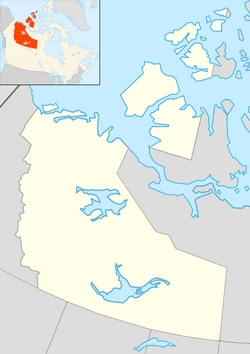Whatì
|
Whatì Wha Tì Tsõtì Mïne Kö Golàa |
||
|---|---|---|
| First Nation | ||
|
||
| Coordinates: 63°08′40″N 117°16′22″W / 63.14444°N 117.27278°WCoordinates: 63°08′40″N 117°16′22″W / 63.14444°N 117.27278°W | ||
| Country | Canada | |
| Territory | Northwest Territories | |
| Region | North Slave Region | |
| Constituency | Mackenzie Delta | |
| Census division | Region 3 | |
| North West Company trading post | 1793 | |
| Incorporated | 4 August 2005 | |
| Government | ||
| • Chief | Alfonz Nitsiza | |
| • Senior Administrative Officer | Larry Baran | |
| • MLA | Jackson Lafferty | |
| Area | ||
| • Land | 59.95 km2 (23.15 sq mi) | |
| Elevation | 269 m (883 ft) | |
| Population (2011) | ||
| • Total | 492 | |
| • Density | 8.3/km2 (21/sq mi) | |
| Time zone | Mountain (MST) (UTC−7) | |
| • Summer (DST) | MDT (UTC−6) | |
| Canadian Postal code | X0E 1P0 | |
| Area code(s) | 867 | |
| Telephone exchange | 573 | |
| - Living cost | 147.5 | |
| - Food price index | 138.4 | |
| Sources: Department of Municipal and Community Affairs, Prince of Wales Northern Heritage Centre, Canada Flight Supplement ^A 2009 figure based on Edmonton = 100 ^B 2010 figure based on Yellowknife = 100 |
||
Whatì (from the Dogrib language meaning "Marten Lakes"), officially the Tłı̨chǫ Community Government of Whatì is a First Nations community in the North Slave Region of the Northwest Territories, Canada. Whatì is located by Lac La Martre, about 164 km (102 mi) northwest of the territorial capital of Yellowknife.
With rich and varied wildlife, the area has long been a favoured hunting ground of the Tłı̨chǫ (Dogrib Dene) Aboriginal people. The North West Company established a trading post there in 1793, and many natives began settling there permanently, while they continued to hunt and fish in the area. With the establishment of a trading post at Fort Rae on Great Slave Lake in the late 19th century, most regional trading was accomplished at the HBC and free traders posts there. A trading post at Lac La Martre was not again established until the 1920s.
On 1 January 1996, the community officially changed its name from Lac La Martre to the Tłı̨chǫ name "Wha Ti", meaning "Marten Lake," the same meaning as the French and then on 4 August 2005 to the current spelling. Other traditional Tli Cho names for the settlement include Tsoti ('fouled water lake') and Mine Go Kola ('net fishing with houses').
At the 2011 census the population was 492, an increase of 7.0% over the 2006 census. In 2006 there were 435 Aboriginal people all of which were North American Indians. In 2012 the Government of the Northwest Territories reported that the population was 519 with an average yearly growth rate of 0.4% from 2001.
While trapping, hunting, and fishing continue to be the main economic activities in this traditional community, efforts have been made to develop tourism as well. A fishing lodge was opened, and many tourists come to see the abundant wildlife, including black bears, barren-ground caribou, gray wolves, and eagles. The community takes special pride in the fact that no alcohol is allowed there.
...
Wikipedia


